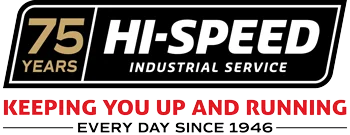Finding the most suitable electric motor enclosure type for your application can save you money, enhance motor performance, and extend the life of your motor. But how do you know what enclosure type you need?
Why It’s Important to Choose the Right Enclosure Type
We can start with the overarching purpose of a motor enclosure: provide protection from moisture, chemicals, abrasive particles, and mechanical to the windings, bearings, and other critical components. Failure to protect these components will have a harmful effect not only on motor performance but also on its life span.
These enclosures also protect other equipment and personnel from the high temperatures and heat generated by your motor. And, a fact that is often forgotten, motor enclosures are also crucial to ensuring that your AC motor is efficiently cooled. Motors that run too hot or in an environment that exceeds their recommended operating temperature are going to perform poorly and have a shortened life.
In addition, the type of motor enclosure is a significant factor in determining the motor frame size and cost. Choosing the wrong enclosure can lead to additional expenses and paying more for your motor and enclosure than you need to. And don’t forget that motor enclosures can help keep noise levels at a minimum!
So, choosing the proper enclosure means …
- Protecting your motor from its operating environment, which is critical to its proper operation
- Protecting personnel and other equipment from the heat it generates, which promotes safety and the performance of nearby equipment
- Keeping it at an acceptable operating temperature, which impacts its performance
- Optimizing the cost and size of the motor
ANSI / NEMA MG-1 Standard Enclosures
Based on the NEMA MG-1 standard, there are two basic categories of motor enclosures: open and totally enclosed. As their name implies, open motor enclosures include openings that allow external cooling air to pass around and over the windings. However, totally enclosed motor enclosures are not airtight but instead limit the amount of cooling air that comes from the external environment of the motor.
ODP (Open Drip Proof)
ODP enclosures are engineered with ventilation holes that prevent the ingress of water droplets or large particles that are approaching the motor at an angle of 15° or less. These enclosures, which are IP12 rated, are designed to allow outside air to freely circulate through the motor windings to keep the motor cool. ODP motor enclosures are primarily used in dry, clean indoor applications. However, they can be used outdoors in some instances as long as they are fitted with a cover that won’t restrict airflow.
TEFC (Totally Enclosed Fan Cooled)
As the name implies, TEFC motor enclosures are enclosed so that inside and outside air don’t freely mix. However, the frame itself is not entirely airtight. Cooling is accomplished through an external fan attached to the motor shaft. The fan blows external air across cooling fins on the outside of the motor frame. This extremely versatile enclosure is commonly used on fans, pumps, compressors, and industrial belt drives.
TEWAC (Totally Enclosed Water-to-Air Cooled)
TEWAC motor enclosures are IP54/56 rated and use a heat exchanger to keep the motor cool. In this type of enclosure, hot air circulating internally passes through passages embedded in a heat exchanger that is mounted on the motor. The heat exchanger contains fluids, such as freshwater or glycol, that draw the heat from the circulating hot air.
TENV (Totally Enclosed Non-Ventilated)
TENV enclosures are very similar to TEFC, but there are no ventilation openings. This means it is even more challenging for internal and external air to mix, but still not impossible because the enclosure is still not airtight. It depends solely on convection cooling because of how enclosed the motor is. TENV enclosures are used when motors may be exposed to dampness or dirt but don’t work well in very humid environments.
WPI (Weather Protected Type I)
WPI (also called WP1) enclosures are an enhanced version of ODP enclosures. They include protective screens that prevent large particles from gaining access to the motor.
WPII (Weather Protected Type II)
WPII enclosures, also known as WP2, are IP23/24 rated and considered an enhanced version of both ODP and WPI enclosures. These enclosures have external ventilation passages that allow high-speed air to discharge without entering any internal ventilating passages. This separation between internal and external air is made possible by including at least three abrupt direction changes, all greater than or equal to 15°, in the flow path.
WDN (Washdown)
For motors that need to be sanitized or cleaned regularly, a WDN motor enclosure may be necessary. They are IP55 rated and can be found in food and beverage processing, medical manufacturing, and the pharmaceutical industry.
Choosing the Right Motor Enclosure
Here are some questions to ask to help you narrow down the suitable motor enclosure:
- What is the motor going to be used for?
- What type of motor are you currently using, including the type, frame size, and specifications? (if applicable)
- What kind of contamination is potentially present in the operating environment?
- Will the motor be installed outside?
- Is there a risk of high humidity or water exposure?
- How much cooling will your motor need?
- Will your motor need to be regularly cleaned or sanitized?
- Could heat generated by the motor pose a safety hazard to your employees or affect nearby equipment?
Conclusion
When presented with new motor options, including the enclosure types, the selections can be overwhelming. To obtain the best value for your electromechanical equipment, you should focus first on the application and the actual requirements that need to be taken into account–this always helps prevent overspending on features that are not required.
At Hi-Speed Industrial Service, our team of motor experts will work with you to find the proper motor enclosure for your application. We’ll help you with any step of the motor selection process you need, from establishing the motor specifications and frame size to the proper NEMA motor enclosure. Our goal is to help you get the most for your money without overspending or over specifying. So, contact us today and let us help you!

